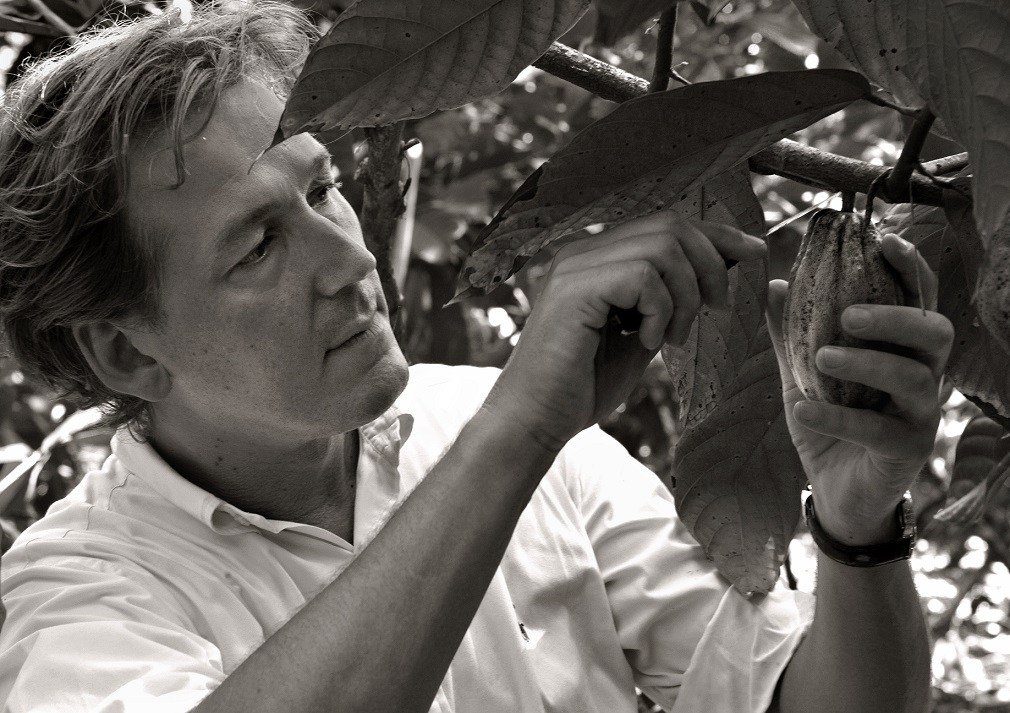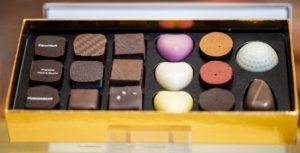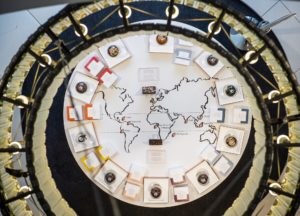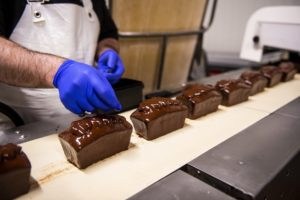Pierre Marcolini could be the most celebrated chocolatier in the world, his elegant boxes of exquisite concoctions available around the world. Critics say his reputation is built on suave marketing, but as I discovered, Marcolini is driven by an obsession with producing the perfect chocolate.
“It’s the feeling like when you in fall love,” says Pierre Marcolini of his lifelong relationship with chocolate. “The first step is just connecting. Then the second step is marriage. The third step is babies and so on. And the passion is still there.”
Marcolini certainly has a hunger for chocolate. He created his brand, simply called Maison Pierre Marcolini, more than a quarter of a century ago, and it has made him arguably the most famous chocolatier working today.
His affection for confection began in his teens when he trained as a pastry chef at the Centre d'Enseignement et de Recherches des industries Alimentaires et Chimiques (CERIA) in Anderlecht. He hit the sweet spot with chocolate and never looked back.
His ‘marriage’ wasn’t initially supported by his Belgian parents, who envisioned a more traditional career for their son, who was born in Charleroi in 1964 (the Italian surname comes from his maternal grandparents from Verona).
“My parents absolutely did not want me to be a chocolatier,” he says. “I think they wanted me to be a lawyer, a banker (horrible!) or a doctor. When I told my mother, ‘I'm going to be a pastry chef who makes chocolate,’ she said, ‘What?! That’s a simple job.’ I replied, ‘Sorry, mommy, I really want to do this.’”
But Marcolini persisted, completing an apprenticeship with Belgian pastry pioneer Henri Wittamer III, and then working for him as head of decoration. He was 31 when he won the 1995 World Pastry Cup in Lyon with “a very innovative cake with mixed textures,” including chocolate, chocolate mousse, orange crème brûlée and hazelnut crust. That led him to open his first shop outside Brussels, in Kraainem.
In 1997, he opened his first chocolate shop in Brussels, in the Grand Sablon, across from his former mentor, Wittamer, triggering what he jokingly calls “the war.”
“’The war’ was normal because I worked at Wittamer for two and a half years, then I moved across the street,” he explains. “Paul Wittamer, who is the owner now, said ‘the house of Wittamer is like a university of pastry’ and that's really it. When you look today at all the pastry chefs that have come out of this beautiful house – whether it's Marcolini, Van Dender, Marc Ducobu, Jean-Philippe Darcis, etc – there have been many, many people of the new generation who learned from Wittamer. It was a house that taught me a lot.”
The bean-to-bar concept
But Marcolini’s conceptual leap came later, in 2001, when he introduced bean-to-bar production, a system that allows him to control quality at every step of the process. This includes sourcing from tree to bean; storing and roasting cocoa beans; refining (finely crushing beans with sugar and sometimes milk powder into a smooth paste); conching (emulsifying the paste for 48 hours) and moulding or creating chocolates. Roasting brings out up to 115 aromatic notes in cocoa from bitter and woody to floral and fruity. Crushing the beans releases their full flavour. All chocolates, including those filled with ganache, praline or other confection, are handmade.
Few chocolatiers oversee the entire supply chain process, with most only buying the chocolate from larger factories after conching. But this, Marcolini says, is too late. “The definition of a chocolatier is one who makes chocolate,” he says. “There is a difference between moulding chocolates for a large mass market versus creating those for tasting. The new generation of artisan chocolatiers is interested in bean-to-bar production. It’s a kind of revolution that we’ve seen with coffee, tea, olive oil and wine.”
Marcolini’s is widely praised for his bean-to-bar innovation, and for his engagement with the growers in Africa, Asia and Latin America. “Twenty years ago, I thought we should work from cocoa beans and pay planters properly. Today, this is trendy,” he notes. “As well, our chocolates were more intense with unusual combinations, such as with tea or jasmine, which had never been done before. For example, we made the first pepper-based chocolates in 1995. I remember colleagues, who are chocolatiers, telling me I was crazy, that it would never work. And now, all the big brands are doing the same thing.”
It was this pioneering approach that attracted interest in Japan, prompting him to open a shop in Tokyo in 2001 – another first in the industry. At that time, chocolate was new to Asia: the palate is more bitter and less sweet, so dark chocolate was a good fit. It’s now a symbol of gastronomic luxury and prestige.
“Japan was the first Asian market to discover chocolate and it immediately recognised a difference between mass-manufactured versus handmade products in terms of taste,” Marcolini says. “What’s important for the Japanese is that it’s an ‘author's chocolate.’ From the beginning, compared to other Belgian chocolatiers, we made our chocolate much less sweet. We were the first to make ganache and chocolates with 70 percent cocoa, while the national average was 50-55 percent. Still today, our chocolate is more intense, innovative, smaller and packaged so that you can see all of it.”
This year marks the 20th anniversary of Marcolini’s bean-to-bar production. To celebrate, he released 20 new chocolate tablets – a format he considers the chocolatier’s essential identity – including 10 “grands crus” (pure chocolate from cocoa-growing terroirs) and 10 creations (chocolate mixed with other ingredients).
His flagship Sablon store features a “cocoatechque,” to showcase bean origins. They include rare locations like Hainan Island in southern China, a small coastal town in Cuba (only 2-3 chocolatiers in the world have access to these beans) and Chuao region of Venezuela (only accessible by sea).
Defining fine chocolate
According to the Fine Chocolate Industry Association, “fine chocolate is defined in terms of its flavour, texture and appearance as well as how its limited ingredients, high cocoa and low sugar content are sourced and processed.” It represents 5 percent or less of chocolate market sales and includes:
- Sustainable sourcing: Committing to farmers and ethical practices, sourcing the highest quality cocoa beans, often from single countries of origin and individual growers.
- Sensory perfection: coaxing unique flavours from cocoa beans so that their terroirs shine. Textures must be smooth and creamy (unless purposely for unrefined chocolate).
- Minimal processing: artisan methods create minimally processed chocolate with flavour complexity.
- Visual appeal: creation of stunning, perfectly finished products and artful designs.
Marcolini ticks all four boxes. Indeed, he’s written two books on bean-to-bar production, most recently ‘Belgian Chocolate: Bean-to-Bar Generation’ (Lannoo 2018). While this style is slowly increasing among artisan chocolatiers, Marcolini remains one of the few to partner with growers and roast cocoa beans himself. His beans come from eight independent plantations in the "Cocoa Belt," tropical regions located 20° north and south of the equator, including Cuba, Peru, Venezuela, São Tomé and Príncipe, Madagascar, Indonesia, India and China.
“The difference is in the DNA: the style, flavour, approach and philosophy,” Marcolini says. “People always think that it is the percentage of cocoa that makes the most difference in taste. And I say no, it's the origin, it's the bean, it's the region.”
The tour du monde en chocolat is essential for the Marcolini experience. He even sets the scene as people dip into his boxes. “You sit down and take off your shoes,” he imagines. “It's evening, there's a small fire crackling. You put on some jazz music and you take a little square of chocolate and say to yourself, ‘I want to travel. I want to travel in taste from Cuba to Madagascar to India.’”
Marcolini does travel the world in search of new cocoa beans and other exquisite ingredients. For example, he imports pink peppercorns from Morocco, pistachios from Iran, pepper from China, vanilla from Madagascar, lemons from Sicily, cinnamon from Sri Lanka and hazelnuts from Italy. These ingredients are untainted by artificial flavours, colourants or preservatives.
Marcolini only works with sustainable plantations that have ethical worker and environmental practices. He sources fair-trade cocoa at premium prices (two-to-three times the market rate) and maintains close relationships with his growers for long-term supplies. Maison Pierre Marcolini and its cocoa growers are also moving to cut their carbon footprint: the workshop has solar panels, rainwater collection and biodegradable packaging.
Pierre and the chocolate factory
As for the workshop itself, based in Haren, just outside Brussels, a visit is like getting a golden ticket to the Willy Wonka Chocolate Factory. The warehouse receives and stores bags of cocoa beans from around the world.
In an adjacent building, 11 rooms are used to 1) roast and crush beans; 2) grind and liquefy them; 3) blend cocoa liqueur with sugar or sugar and powdered milk to create dark and milk chocolate paste, then powdery flakes are ‘conched’ back into liquid; 4) design and cut chocolates into special shapes; 5) create ganache or other chocolate fillings; 6) create macaroon fillings; 7) create macaroon shells and assemble them with filling; 8) make other pastries like cakes; 9) coat pastries in chocolate; 10) package products and 11) test new ideas (Marcolini is in this “lab” every Saturday morning).
The bean-to-bar process takes three days while turning out a box of chocolates an entire week. About 80 artisans handcraft and design everything, overseeing limited automated processes.
Then there is the packaging. Marcolini’s clean, elegant boxes look like they were built by Apple or Tesla. His stores have a matching virtuosity. While critics assert that he focuses too much on marketing and design, Marcolini insists that high-quality products deserve high-quality packaging. He just wants to give customers an emotional experience from store to stomach. “The first thing we try to do is to transport people via emotion. It starts with the look, with a window or with a store 360-degree experience. If you go into a restaurant that doesn't look like much, but it gives you a nice plate, there's something wrong with that,” he says.
Today, Maison Pierre Marcolini is a global luxury brand with 40 stores in eight countries: Belgium, Luxembourg, France, Monaco, Britain, United Arab Emirates, China and Japan. In 2020, Marcolini opened a shop in Victor Hugo’s former home on Brussels’ Grand Place, a second store in Dubai, UAE in its famous Emirates Mall and a boutique plus workshop producing ‘grands cru’ tablets in Antwerp.
This Christmas, he is offering a ‘magical mountain’ advent calendar with a ski resort theme and winter animals like polar bears as well as chocolate-based yule logs, Christmas trees and wreaths. Also new are star-shaped hazelnut chocolates derived from gianduja of Turin, Italy as well as whisky- and rare rum-infused chocolates with earth colours from plant-based sources such as raspberry and carrot powders.
So, what is the best way to enjoy his chocolates? “At home in a temperature of about 20 degrees in a quiet place,” Marcolini advises. “First, you smell it, look at it and feel it. Then you take time to taste it and let it melt in your mouth. And then you wait to see how long the taste will stay.” This is when chocolate buffs refer to the Caudalie, the unit of measurement used to determine how long a flavour persists. “At that moment, you have a beautiful tasting.”
Some connoisseurs can even taste the author’s signature. "What I would like is when you taste a chocolate, when you taste a bar, when you taste a praline, you say ‘This is Marcolini,’ he says.
Conversely, a world without chocolate would be unbearable: “How awful! Oh no, no, no! Chocolate is a universal product that makes faces light up and people say, ‘This is super, this is awesome.’”






